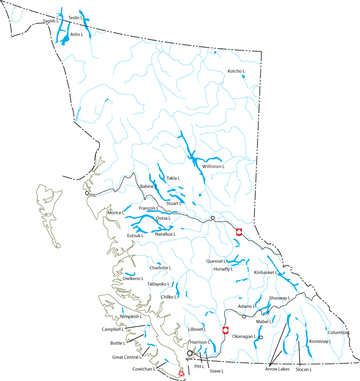Cheslatta Lake
| Cheslatta Lake | |
|---|---|
| Location | British Columbia |
| Coordinates | 53°44′N 125°21′W / 53.733°N 125.350°WCoordinates: 53°44′N 125°21′W / 53.733°N 125.350°W |
| Primary inflows | Cheslatta River[1] |
| Basin countries | Canada |
| Surface area | 35.0 (km2)[2] |

Cheslatta Lake is a large freshwater lake located between François Lake and the western end of the Nechako Reservoir, Range 4 Coast Land District.[3] It is in the Regional District of Bulkley-Nechako,[Notes 1] British Columbia.
Etymology
The name derives from the Dakelh (pronounced [tákʰɛɬ])/Carrier people word meaning either 'top of small mountain' or 'small rock mountain on east side'.[4] Cheslatta Lake appeared on Trutch's 1871 map of British Columbia as "Chestatta" Lake. In 1884, the spelling was changed to Cheslahta on Mohun's map of British Columbia. In 1891 the name was spelled as "Cheslata" Lake on Poudrier's map of Northern British Columbia. In 30 March 1917 the name "Cheslatta Lake" was adopted in the 15th Report of the Geographic Board of Canada based on the label on Jorgensen's 1895 map of BC, and as labelled on pre-emptor map 1G, 1916.[3]
Trophic levels
The ecosystems of both Cheslatta Lake and the smaller Murray Lake it joins, prior to the flooding by Kenney Dam construction, "were quite productive at all trophic levels including fish, as it is reported the fisheries of these lakes were utilized for centuries by first nation’s people as traditional fishing grounds."[5][6]
Impact of Kenney Dam
The Construction of the Kenny Dam in the 1950s on the Nechako River, reversed water flow and sent water westward to generate electricity for use and sale by the Alcan corporation, devastated the area around Cheslatta Lake, flooding the Cheslatta Carrier Nation village and cemetery and forcing the First Nations to be relocated with little time for preparation and no consultation. Prior to the flooding, Cheslatta Lake was at the centre of the CCN traditional hunting and trapping territory. Before 1957 the Cheslatta River was a small stream with an average annual flow of about 5 cubic metres per second (180 cu ft/s).[7] Alcan began releasing water flows far above the Cheslatta's natural capacity, resulting in a deep channel being carved out and large-scale erosion filling the Cheslatta and upper Nechako Rivers with sediment.[7] In addition, the area between the Skins Lake spillway and the headwaters of the Cheslatta River was not a river but rather a series of meadows, pastures, and small lakes. Water released from the reservoir scoured the area between Skins Lake and Cheslatta Lake. Soil, gravel, grass, moss, shrubs, and trees were washed away, down into the Cheslatta River and into the Nechako River.[7]
There has been a 7-fold decline in the productive capacity of Cheslatta Lake to support pelagic fishes, namely kokanee salmon.[2]
Notes
- ↑ The boundaries of the Regional District of Bulkley-Nechako near-entirely coincide with the territory of the Dakelh or Carrier peoples. Roughly identical in area to the old New Caledonia fur district in the days of the North West Company.
Citations
References
- "Cheslatta Lake", BCGNWS (British Columbia Geographical Names Web Service), nd
- Akrigg, Helen B.; Akrigg, G.P.V, British Columbia Place Names, Victoria, BC: Sono Nis Press
- "Background information report: Murray-Cheslatta River system: Contract report prepared for the Nechako Enhancement Society", Golder and Associates Ltd., 2005: 29
- Schmidt (2005), Report of the Cheslatta Watershed (PDF)
- Wood, June (2013), Home to the Nechako: The River and the Land, Heritage House Publishing Co, pp. 13,40–47, ISBN 978-1-927527-13-9, retrieved 5 August 2013
- Carlson, Roy L. (1978), Charles E Borden, Canadian Archaeological Association, retrieved 3 December 2013
- Knickerbocker, Madeline (2012), "Review of Susan Roy's These Mysterious People: Shaping History and Archaeology in a Northwest Coast Community", BC Studies The British Columbian Quarterly (174)
- Roy, Susan (October 2010), These Mysterious People Shaping History and Archaeology in a Northwest Coast Community, McGill/Queen's University Press, p. 240, ISBN 9780773537217
- Knickerbocker, Madeline (2012), "Review of Susan Roy's These Mysterious People: Shaping History and Archaeology in a Northwest Coast Community", BC Studies The British Columbian Quarterly (174)
- Stockner, John; Slaney, Pat (30 April 2006), Cheslatta/Murray Lakes and River System: The Role of Hydraulic Flushing on Lake and Stream Primary Productivity and Ecosystem Recovery (PDF), Vancouver, BC: Eco-Logic, retrieved 8 December 2013
See also
Cheslatta River
Kenney Dam
Nechako Reservoir
| ||||||||||||||